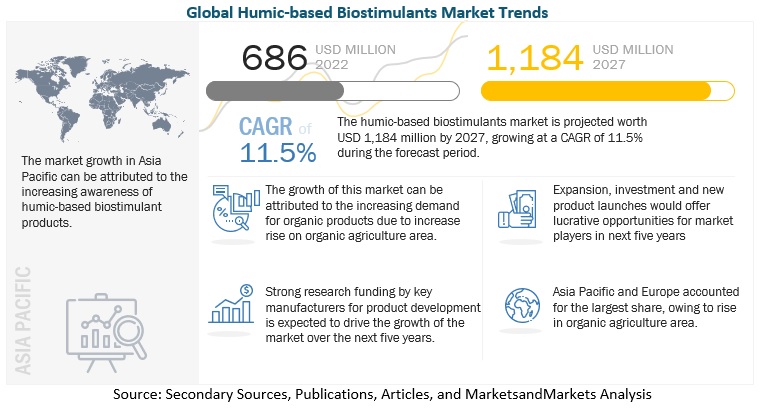The global humic-based biostimulants market is estimated to be valued at USD 515 million in 2020 and projected to reach USD 848 million, with a CAGR of 10.5% between 2020 and 2025. The growth of the humic-based biostimulants industry is driven by various factors, such as the enhancement in the crop productivity with improvement in the quality and quantity of the crops, demand for sustainable solutions to preserve the biodiversity and to achieve the export standards of the crop produce.

Humic-based biostimulants Market Dynamics:
Opportunities: Technological advancements for biostimulant production
Technological innovation in the biostimulant sector creates the opportunity for manufacturers to develop new products in the biostimulant and plant growth promotor segments. Initially, biostimulants were only used for vegetables and fruit crops, along with other high-value crops such as ornamentals and plantation crops. Now, they also play an importunate role in traditional food crops such as corn, wheat, and rice, by being used as an added compliment to fertilizers to catalyze the nutrient uptake process of the crops. One of the other latest technologies also includes the production of humic-based biostimulants chelated with NPK and biostimulant resistant to hard water, which will gain more traction in the future.
Download PDF Brochure: https://www.marketsandmarkets.com/pdfdownloadNew.asp?id=45726696
Challenges: Uncertainty in the regulatory framework of biostimulants
Humic-based biostimulants have not yet been governed under any standard categorization across the globe. Currently, biostimulants are not classified as a specific category with a consistent global definition. For instance, they are considered as additives in France, whereas in Germany, they are marketed as plant strengtheners or growth enhancers. To consolidate the regulatory framework with respect to biostimulants in Europe, the European Biostimulants Industry Consortium (EBIC) drafted a directive based on the views and suggestions of manufacturers and research institutes and tabulated it for EU approval. The data requirements and parameter range also vary according to each country in the EU.
By mode of application, seed treatment is projected to be the fastest-growing segment in the humic-based biostimulants market during the forecast period.
Seed treatment is projected to grow at the highest CAGR in the humic-acid biostimulants market. With modern technology, farmers are becoming aware of the seed treatment method, which requires less labor, time, and water. This mode of application is gaining importance due to its reliability and efficacy. However, to get the desired results using this method, proper knowledge of the system and efficient management are required. It is projected to drive the market in the next six years, particularly in North America and Europe.
The increasing demand for sustainable solutions in the Asia Pacific regions drives the growth of the humic-based biostimulants market.
The agriculture industry in Asia, particularly in the Southeast Asian countries, witness effective transformation due to various technological advancements. The increase in agricultural practices and demand for agricultural produce which can meet the international standards are the factors that are projected to drive the humic-based biostimulants market in this region. It has produced high-quality biostimulants and has patented various new bioactive molecules. Asian countries, such as China, Japan, southeast countries are shifting toawards sustainable agriculture. Hence, the demand for Humic-based biostimulants is high in the region.
Make an Inquiry: https://www.marketsandmarkets.com/Enquiry_Before_BuyingNew.asp?id=45726696
This report includes a study on the marketing and development strategies and a study on the product portfolios of the leading companies operating in the humic-based biostimulants market. It consists of the profiles of leading companies like Bayer AG (Germany), FMC Corporation (US), UPL Ltd(India), Borregaard (Norway), Koppert Biological Systems (Netherlands), Valagro SpA (Italy), Biolchim SpA (Italy), Haifa Group (Israel), Sikko International Ltd (India), Novihum Technologies GMBH ( Germany), Humintech GMBH (Germany), Qingdao Future Group (China), Promisol (Spain), Bioline (Canada), Humic Growth Solutions (Florida), Actagro (US), Rovensa (Portugal), Tagrow (China), CIFO (Italy) and Loveland (US).
Recent Developments:
- In July 2019, Koppert acquired Nitrasoil (Argentina) and its industrial unit in Argentina. With this, Koppert intended to expand the range of its products and cater to the southern US.
- In July 2019, Valagro announced a research collaboration with Marrone Bio Innovations (US) to leverage their assets to develop plants that can thrive under harsh conditions, grow with more vigor, and have better root systems.
- In October 2019, Humintech has expanded its production capacity and moved to a new production plant to produce new Humic acid granulate.